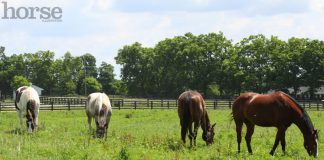
Q: My six-year-old off-track Thoroughbred was diagnosed with osteochondritis dissecans in either his hip or his stifle. I’ve heard differing opinions from various vets and trainers about what he can or cannot do. What are the limitations on a horse with this condition?
There are lots of theories as to why OCD occurs. Genetics, stress, trauma, growth rate, and even nutrition are thought to play a part in the development of this condition in animals (OCD occurs commonly in large breed dogs and in pigs as well), proving that bone growth and development is an extremely complicated process involving numerous factors that is still not completely understood.
There is no straightforward answer to your question, as it is very dependent on the extent of the OCD lesion. Horses that have OCD lesions are usually minimally lame and may have some joint swelling. Sometimes horses with OCD are not lame at all and the diagnosis of OCD is merely an incidental finding on a radiograph for a pre-purchase exam. However, any lameness (or potential for lameness) on the racetrack is a bad lameness and most racehorses with OCD lesions undergo arthroscopic surgery to have the small fragment(s) removed.
OCD lesions are scored according to their size and it should be no surprise that the smaller the score (meaning the smaller the lesion), the better the prognosis is for the horse after surgery. For many cases of OCD, full recovery back to racing status is reported to be roughly 60–70 percent for smaller lesions and lesions that were not causing any clinical signs in the first place. Please note this recovery data is for horses returning to the track, meaning that horses such as OTTBs that are no longer competing at that level are likely to do even better. For larger OCD lesions and those that were causing considerable lameness and/or joint effusion, the prognosis is not as great, but varies by the location of the lesion(s), what damage to the joint has already occurred, and how well post-operatively the horse heals. Many times, this is the cause of retirement of a racehorse. Some horses will still have joint effusion after surgery. However, in general, horses recover very well from this form of treatment.
You don’t mention if your horse is lame, or if he has had surgery to remove the lesion, or if it is still there. If the lesion is still present and the horse is not lame, there are not many restrictions on his use. One recommendation would be to take all new activities slowly at first and gradually increase his level of fitness, but in terms of limiting activities, it’s hard to say. I would closely monitor whichever leg the lesion is on for signs of joint swelling or heat and obviously lameness. You may also consider routine radiographs perhaps every year or so to monitor the joint itself for signs of degradation that could lead to degenerative joint disease in the future. Basically, if your plans are to create a Grand Prix jumper out of him, and if he is sound, there’s not much reason why you shouldn’t see how far he can go. Just think, there are likely many horses out there being used every day that have an OCD lesion or two and no one ever knows.






informative
What does OTTB mean?!
OTTB means Off-The-Track-Thoroughbred.
Boy, one more thing I will have to worry about, but I am glad to have the newest information.
So sad.
I want to know who came up with the name joint mice…lol
Oooh they picked my question!! Yay! Pari isn’t lame, but he didn’t have the surgery to remove the legion. I guess the next step is to call the vet who was in charge of him while he was racing and find out his recomendations. Thanks for the info HC!!!
Something people love to use as an excuse to lower the purchase price of a horse. We were lied to by purchaser and got proof when we bought him back 3 years later. Not ever a lame day. No swelling ever. Got him at 4 months of age and sold him when he was just about 8. Bough him back 3 years later and saw the X-rays etc. Our Vet says there’s no OCD on X-rays. He would know and he knew that horse from the age of 4 months as did our farrier. Both got very upset about the supposed OCD. I will not ever again sell any horse. End of story. Our beautiful boy was ruined and I spent 5 years getting him back. 3 years with buyer and his immune system was not what it had been and the horse was so changed I had to restart him from scratch. Anyhow, anything OCD, get several opinions from good vets and don’t worry before needed to be worried about. My Vet always says – keep young horses lean and don’t rush them. Light work at the age of three and don’t start more serious work until at least f our or five. While horses grow is when this tends to be a problem and most people forget horses grow until they’re about the age of 8.